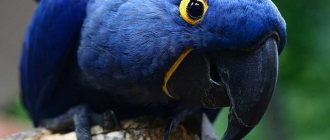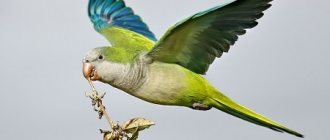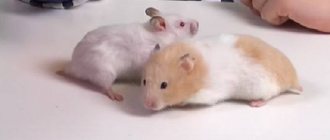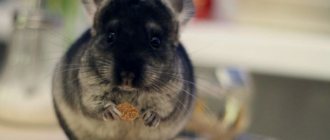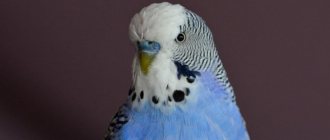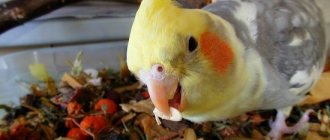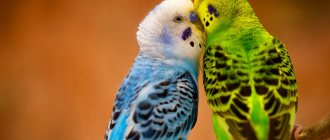The Amazon Parrot is a bird for those who value intelligence, sociability and beauty. If this is your first time getting a parrot, know that this representative is an excellent choice even for beginners. Reviews from owners are mostly positive: active, cheerful, friendly, sociable, lively, inquisitive, smart, artistic, loving their owners and at the same time noisy, arrogant, quarrelsome and talkative, especially in the morning.
Let's talk about keeping and caring for these unusual pets so that communication between you brings mutual pleasure.
Intelligence and character
In terms of intelligence, Amazons are second only to the gray African Gray. Trainable, sociable, quickly get used to new things.
Character and intelligence of a parrot
Characteristic features include hyper-emotionality, a tendency to jealousy, and rapid and frequent mood swings. Therefore, you need to monitor your pet and its psycho-emotional state. The harbingers of a bad mood are clearly visible in him - and then it is better not to approach him without something tasty. Even small children, for whom these parrots have a soft spot, can be harmed by a fit of jealousy or simply a quarrelsome nature.
How to choose a chick
It is better to buy a parrot from a nursery. Suitable age is 4-6 months. The price depends on the type of Amazon and its abilities. In European countries, a chick costs about $500-700. For some individuals they can ask for 1000-1200 dollars.
When purchasing from Amazon, you should make sure that the parrot is banded and healthy. The parrot's good health is evidenced by even, dense plumage, clear, clean eyes, and measured breathing. The chick must remain calm when seeing people and make contact.
Amazon will be an ideal pet for exotic lovers. This parrot has many advantages, including beautiful appearance and the ability to speak.
Appearance
Basically, the difference between a male and a female in size is very insignificant, and in onomatopoeic abilities too, but the appearance, as they say, is variable. Nature did not spare bright colors for the plumage of this bird.
A feature of Amazons is sexual dimorphism: in rare species, females can be distinguished from males by their appearance. Basically, in order to figure it out, parrots are gathered into a heap: parrots of the same sex will behave indifferently, and in a male-female pair, the men immediately begin to court the ladies.
But this is if they have already matured to the desire to reproduce. You can distinguish a mature parrot from a chick and a teenager by the color of the iris: in adults it is bright orange, reddish-brownish, and in young animals it is bluish-brown.
Appearance of an Amazon parrot
Description
Amazon parrots are large birds. The size of the body is 25 - 45 cm, while the weight of the pet can reach 500 g. The bird has bright, dense green plumage, which may have red, yellow or blue spots on the forehead, back of the head, wings, cheeks, tail or chest. They are used to determine whether a parrot belongs to one species or another. The beak of the Amazon parrot is strong, smooth, shiny, short, has a sharp-edged base and a curved end. It is capable of crushing large nuts.
The age of a bird is determined by the iris of the eye. In young individuals it has a grayish tint. In birds that have reached the age of three, the iris becomes chestnut in color. After this, determining the age of the parrot becomes very difficult. You can find out the sex of a bird by its behavior during the mating season. If there is only one individual, then only a veterinarian can determine it.
Kinds
All Amazons are native to the Caribbean, Central and South America. They differ in the color of their plumage. Therefore, the names of species are determined either by geographical range or by coloration characteristics.
White-fronted and blue-fronted
The white-fronted (red-spectacled) parrot lives in tropical rainforests and is the smallest Amazon. Lives up to 50 years, is easy to handle, but does not like the cold.
Blue-fronted (red-shouldered) is found in Argentina, Bolivia, Brazil and Paraguay, lives in tropical forests. In the house he lives up to 90 years, in nature - as it turns out.
Yellow-shouldered and yellow-necked
The yellow-shouldered (yellow-winged) Amazon inhabits the bushes on the plain of the island. Bonair in Venezuela. Previously lived on Aruba, but was completely exterminated. Critically endangered and protected by CITES.
The Yellow-necked Amazon lives from Mexico to Costa Rica and is very popular among parrot lovers because it is extremely trainable, human-oriented, and screams less than other parrots.
Yellow-shouldered and yellow-necked parrot species
Venezuelan and red-tailed
The Venezuelan (orange-winged) Amazon also lives in Peru, Colombia and Brazil. Females are similar to males. They live in a cage for up to 70 years. If you don't educate them, they like to yell early in the morning and for various reasons. Outside the cage, he does not enjoy people's favor, since he is a notorious agricultural pest.
The red-tailed (Brazilian) Amazon loves to live in mangrove swamps and tropical jungles. Not that untalented, but less talented than his brothers. It is kept at home by lovers of rare breeds: 20 years ago the population numbered 3,000 birds. It is protected by CITES.
Red-throated and red-fronted
The red-breasted Amazon lives in the Antilles and Brazil. It is protected by the international treaty on the protection of the natural environment CITES. At the beginning of the 20th century there were only 400 individuals.
The red-fronted (yellow-cheeked) Amazon is called “autumn” in Latin (Amazona autumnalis) due to the predominance of red-orange-yellow tones in the color of the feathers. Range: Ecuador, Mexico, rest of South America. A very beautiful bird, but noisy and biting - just because of an excess of feelings.
Red-breasted and red-fronted Amazon parrot
Jamaican black-billed and yellow-billed
The Jamaican Black-billed and Yellow-billed Amazons are critically endangered. To a greater extent, this is due to the fact that their habitat, the tropical moist forests of Jamaica, is shrinking. The second reason is poaching.
Blue-cheeked and blue-capped
The blue-cheeked (orange-winged) Amazon lives in the most stuffy swampy areas of South America - Guyana and Suriname, in certain regions of Venezuela and Brazil. One of the rarest species.
The blue-capped (lilac-headed) Amazon inhabits Mexico from oak and coniferous forests to tropical jungles. It raids banana plantations, so farmers are struggling with the population. That's why CITES has protected them since 2004. The population size is close to critical - 7-10 thousand birds.
Cuban and soldier
The Cuban (white-headed) Amazon lives in Cuba, the Bahamas and the Cayman Islands. The Latin name "leukocephalus" corresponds to the synonym "white-headed".
Cuban and soldier parrot subspecies
The soldier's Amazon inhabits the subtropics and tropics of Colombia, Venezuela and Ecuador.
Royal and Imperial
The Royal Amazon lives on the Saint Vincent Islands, hence the second name Saint Vincent. Poaching of this species of parrots led to the fact that in 2000 there were no more than 500 individuals. It is protected by CITES.
The Imperial Amazon has chosen the Antilles and Dominican Islands. One of the largest varieties. Has a trumpet-like loud cry.
These beautiful, powerful birds suffered more than others from all imaginable misfortunes - by 2000, only 100 individuals were counted. The reason is poaching, hunting for the purpose of eating delicious meat, and constant hurricanes that destroy their habitats. Are protected by CITES.
Surinamese and yellowhead
Found from Mexico to Peru and Brazil. The classification of this subspecies is constantly changing. Birds are not prone to flocking; they often live in pairs. They are loved by home poultry farmers for their affectionate disposition and trainability.
Suriname and yellow-headed Amazon parrot species
Mueller
Amazon mullerian is also called flour. Lives in Central and South America. The largest parrots weigh up to 700 g, length up to 42 cm. When they are kept in captivity, it is necessary to provide opportunities for their physical activity, otherwise the birds may become obese. Especially jealous and aggressive parrots.
Violet
The purple (Guadalupe) Amazon is an extinct species. The last image is from 1905. It was endemic to the island. Guadeloupe.
Martinican
The Martinique Amazon also became extinct when the natural environment in Martinique collapsed.
Festival
The festival (holiday, blue-bearded) Amazon inhabits all of South America. He is loved for his talkativeness and intelligence, but he lives no more than 25 years.
Festival Amazon Parrot
A smart parrot that can be tamed and taught to talk and do tricks.
Luxurious
The luxury Amazon owes its name to its bright, multicolored colors. In the wild, it lives in Paraguay, Argentina and Brazil (for the most part). It was the Brazilian government that paid attention to the population decline in time, and thanks to the measures taken, in 1997 there were about 16,000 luxurious birds.
Blue-capped
The blue-capped (lilac-headed) Amazon is a resident of Mexico, where it is treated as a pest of banana plantations. This caused the population to decline to 10,000 individuals. It is protected by CITES.
Blue-cheeked
The blue-cheeked (orange-winged) Amazon is a very rare species, living in the wild thickets of Guyana, Suriname, Brazil and Venezuela.
Blue-cheeked parrot
Blue-faced
The blue-faced Amazon (Amazona versicolor) is native to the island of Saint Lucia and is its national symbol. In 2000, there were no more than 400 individuals.
yellow bridle
The yellow-bridled (Yucatan) Amazon inhabits Mexico, Honduras, Belize and the islands of Roatan and Cozumel. Leads a nomadic lifestyle; during the daytime, the flock numbers 50 parrots, and at night they can gather up to one and a half thousand.
Puerto Rican
The Puerto Rican wild Amazon, living in the rain forests of Puerto Rico, is under constant surveillance and protection.
Cavalla
Amazon Cavalla, white-faced - Central Brazil and the Amazon basin. The most unknown variety to science.
Amazon Cavalla parakeet
Green-cheeked
Green-cheeked lives in Mexico. But there is also a North American variety.
Varieties
The most famous varieties of Amazon parrots that are suitable for keeping at home:
- The Surinamese, also called the yellow-fronted Amazon, is a medium-sized parrot. The length of its body is less than 40 cm. It has green feathers all over its body, and there is a yellow spot on the frontal part of its head.
- Amazon yellow-headed is a parrot with a body length of 40-41 cm. The head and front of the neck are painted bright yellow. A dark green edging runs along the back, chest and neck. There are red blotches on the upper part of the wings. Some representatives of this species may have lemon spots on other parts of the body.
- Red-fronted Amazon. This parrot is also called the yellow-cheeked parrot. He has a bright, memorable appearance. The body is medium-sized - 34-36 cm in length, weight - 350-480 g. Males are larger than females. The red-fronted Amazon is green, there is a black edging on the back of the head, a bright red spot on the forehead, and yellow cheeks. Powerful paws are painted gray, the color of the iris is orange.
- Muller's Amazon is a large bird from the parrot family. Its body length reaches 43-45 cm, and its weight is 500-700 g. The color of the feathers is green with a light gray tint. When you look at the parrot, you get the impression that it has been sprinkled with flour. A distinctive feature of Muller's Amazon is a purple-gray edging on the back of the head. There is a lemon stain on the forehead. The iris of a parrot's eyes is chestnut-brown or red, and its paws are gray.
- The white-headed Cuban Amazon is a very beautiful medium-sized parrot: body length - 30-35 cm, weight - 350-450 g. Its peculiarity is a large white spot on the head, which extends to the frontal part, covers the eyes and reaches the top of the head. The neck, cheek area and part of the chest are colored pink-red. There is a purple spot on the parrot's belly, and the flight coverts are colored blue. The paws are brown, the iris of the eyes is brown. The tail plumage is emerald green with a bright yellow frame. It contains single red feathers.
- Blue-fronted Amazon. This is a medium sized parrot. The length of its body ranges from 35-40 cm. Weight is 400-500 g. On the upper part of the body the plumage is decorated with malachite edging. There is a blue spot on the forehead. The parietal area of the head, neck and cheeks are yellow. The parrot's beak is coal-black, its paws are gray. The feathers on the wing fold are bright red. The eye color of mature individuals is brown or reddish.
- Venezuelan Amazon. This parrot looks almost like a blue-fronted parrot, but it is a little smaller - 30-31 cm in length, its weight rarely exceeds 350 g. There are blue specks on the forehead, and there is a red stripe on the flight feathers. The beak is brownish-yellow, the tip is dark. The eyes are orange.
Care and maintenance
To care for Amazons, you need to provide them with a temperature of at least 22°C and a humidity of at least 60% - this corresponds to their natural living conditions. When the air is dry, parrots begin to itch and develop dandruff, and when the temperature is too low, they catch a cold.
To keep your pet warm and humid, an aquarium or a humidifier is enough.
To prevent the birds from suffering from a lack of sunlight, you can place an ultraviolet lamp above the cage, and in warm weather, take the house out onto the balcony for sunbathing.
Basic concepts about the care and maintenance of an Amazon parrot
Cage structure
The cage should be spacious, have a proper tray (i.e., one that can be easily pulled out, holds food and other debris in sufficient quantities, and can be easily cleaned).
Although the Amazon loves warmth, the cage should be kept away from radiators, heaters, and drafts.
Strong and thick rods and an external deadbolt are required. Inside there should be durable feeders and drinkers, toys, etc., and wheels at the bottom.
Hygiene and water procedures
Amazons love to swim to the point of oblivion; you can arrange baths for them with sprayers even every other day. Other hygiene measures include regular cleaning of the cage and tray, feeders and drinking bowls.
Hygiene and bathing a parrot
Diet
Amazon eats plant foods, least of all grains. He needs kidneys, fruits, berries and vegetables, one third - grains of not the highest fat content. From animal food they give boiled eggs and cottage cheese.
Amazon eats well:
- porridge with water (salt and butter excluded);
- legumes and dried fruits;
- children's fruit and vegetable purees;
- fresh berries, buds, inflorescences, etc.
Sprouted grains are beneficial. Meat is strictly contraindicated, as are potatoes, onions and garlic, avocado, papaya, mango and all kinds of food from the host’s table.
Walking around the apartment
You can walk around the apartment with this type of parrot only if they are the center of your attention, and nothing will distract the owner from contemplating such beauty. But this is not the most important thing.
Walking a parrot around the house precautions
The windows need to be closed before such a walk - especially in the case when the parrot is new in the house, and the desire to break free will overpower the budding friendship with the person. In order for a bird that is stressed in a new place to calm down a little, a walk is necessary; the Amazon will walk and fly, and make sure that he is not a prisoner, but a pet.
A bird that has lived in a house for several years usually returns when its owner calls if it suddenly flies out. But let's not forget about the level of intelligence of this species of parrot. He can decide his destiny at his own discretion - so there is no point in taking risks. Although some individuals will prefer sitting on the owner’s shoulder and cooing with him, his beloved, to walking around the apartment.
By the way, in films about pirates, it is the Amazons who usually sit on the shoulder of the stern one-eyed and one-legged man. Moreover, European gentlemen of fortune on three-masted galleons hunted precisely in the region where these parrots live - in the Caribbean. But cockatoo parrots could only sit on the shoulder of a former British pirate exiled to hard labor in Australia.
Blue-fronted Amazon. All About Pets
History of the breed
The Amazon parrot was first discovered by sea travelers in the mid-19th century in the Amazon River Valley (South America) - hence the name Amazon. The bird remained invisible to human eyes for a long time due to its sedentary lifestyle - it practically does not fly, and its moderate green plumage perfectly hides it in the crowns of trees and bushes.
At first, it was used as a fashionable delicacy - its meat was the basis of the exquisite dishes of famous European chefs, and feathers were used to decorate the dresses and hats of fashionistas of that time. Later, when the parrot accidentally showed its abilities as a mockingbird, they began to be ordered en masse for circus and theatrical performances, as well as for the personal entertainment of wealthy nobles.
It is also useful to read: Necklace parrot
Diseases and prevention
There are many diseases, but if your Amazon:
- got ruffled and disheveled;
- lost appetite;
- began to cough and sneeze, etc.,
You need to urgently contact a veterinarian. Self-plucking, redness of the eyes and cloaca, and discharge from the beak are also alarming.
Amazon
Birds in the wild
Amazons are excellent opportunists, able to adapt to almost any living conditions. The initial main habitat of their habitat is the territory of South Africa, where the name “Amazon” comes from, a derivative of the river of the same name.
The bird is also common in Central America, the Caribbean and Brazil. They live mainly in wooded areas, but isolated representatives can be found in flat and steppe areas.
This species of mockingbird practically cannot fly, but only crosses at low altitude, covering only relatively short distances. The wings are of medium massiveness, but at the same time they are heavy and not very maneuverable. However, in its ability to climb trees, it eclipses all other relatives of its species.
Pictured is an Amazon parrot in the wild:
Is it possible to teach to speak
According to the highest classification, Amazon belongs to androglossia, that is, imitating the human voice. You can easily find hundreds or more videos on the Internet where cheerful, sociable parrots sing songs, answer questions, pester their owners, and so on.
But if the chant can be attributed to simple onomatopoeia without any particular claim to semantic content, then communication with a person is clearly meaningful. The parrot understands the owner’s name, knows its own name, etc.
Amazons are capable of self-learning. They will remember everything that is said in front of them. Therefore, if you do not want to blush in front of guests, do not use obscene language in the presence of this cute bird. Otherwise, people who come to visit will have the impression that most of the parrot’s life was spent in a port hangout.
In order for a bird to learn to speak, you need to constantly communicate with it - then its vocabulary will be formed more reliably, without random inclusions and borrowings. This will not be difficult, since Amazons are sociable creatures to the point of indecency, they live with the slogan “how about talking?” Well, and shout.
SUPER Talking Parrot Amazon YUZIK – Super talking parrot on YouTube
Natural enemies of the Amazon parrot
Photo: What does an Amazon parrot look like?
The natural enemies of the Amazon parrot are, first of all, large feathered predators that hunt in the tops of tropical forests. Parrots can also be hunted by terrestrial predators, which can lie in wait for the birds while they are looking for food in the form of fallen fruits and seeds, raking the ground with their paws.
Large birds of prey hunt Amazons only when the parrots climb to the treetops. While the Amazons feed and communicate with each other, a large feathered predator swoops down on them, grabbing the largest parrot. A strong grip quickly breaks the parrot's spine, causing the bird to die instantly.
Birds of prey cannot hunt Amazons while they are in the lowlands or at least in the middle layer of the forest, since due to their large size they cannot dive on prey, making their way through the thickets of trees.
Amazons are also attacked by large cats, such as oncillas and, less commonly, leopards. These predators skillfully sneak up on birds that have lost their vigilance, after which they make a long jump and instantly kill the prey. Young or old individuals are especially often attacked.
Amazon chicks can become victims of small snakes - both poisonous and suffocating. This occurs when the female is away from the nest while searching for food. At the same time, Amazons can jealously guard their offspring, attacking the predator with a powerful beak and clawed paws.
Periodic wing clipping
Pets may fly away when outside the enclosure or cage. Therefore, you need to do a little trimming of the wings. You will need some things:
- first you need to prepare a hemostatic agent (hydrogen peroxide, for example), which will be needed in cases where young feathers are damaged;
- the pet is wrapped tightly in a towel, because it can scratch with its nails and beak;
- in the wing you need to feel the largest feathers. Only the outer 7 feathers need to be trimmed.
Gallery
- Extant species
- Yellow-headed Amazon (Amazon Oratrix
)
- Cuban Amazon (Amazona leucocephala
)
- Red Amazon (Amazon autumn
)
- Saint Vincent Amazon (Amazona guildingii
)
- White-fronted Amazon male (Amazon Albifrons
)
- Amazon with a red crown (Amazona viridigenalis
)
- Amazon in a lilac crown (Amazon Finnish
)
- Puerto Rican Amazon (Amazona vittata
)
- Hypothetical extinct species
- Martinique Amazon (Amazon martinique
)
- Guadeloupe Amazon (Amazona violacea
)
Intellectual abilities
Like most large parrots, Amazon is endowed with extraordinary intelligence - he is a capable, trainable, talkative companion. The bird easily finds contact with its household.
The favorite pastime of most birds of this species is actively exploring the interior of the apartment . Despite its low ability to fly, the bird easily moves around the house, touching interior items and decor. Character disadvantages include some aggression, but it is inherent only during the breeding season and is easily corrected by special measures.
Do you have a parrot?
Not really
References
- Standard ITIS Report Page: Amazona Archived 2004-10-17 on the Wayback Machine, entry last updated 1998 (URL accessed May 22, 2006)
- Lesson, René (1831). Traité d'Ornithologie, ou Tableau Méthodique
(In French). Paris: FG Levreau. paragraph 189. - Salvadori, Tommaso (1891). British Museum Bird Catalog
. Volume 20. London: British Museum. paragraph 268. - Jobling, James A. (2010). Helm Dictionary of Scientific Names for Birds
. London: Christopher Helm. n.. ISBN 978-1-4081-2501-4. - Eberhard, J.; Bermingham, E. (2004). "Phylogeny and biogeography of the Amazon ochrocephalus
(Aves: Psittacidae) complex."
Auk
.
121
(2):318–332. Doi:10.1642 / 0004-8038 (2004) 121 [0318: PABOTA] 2.0.CO; 2. - Silva, Tony; Guzman, Antonio; Urantówka, Adam D; Matskevich, Pavel (27 June 2022). "A new taxon of parrots from the Yucatan Peninsula, Mexico—its position in the genus Amazona based on morphology and molecular phylogeny." PeerJ
.
4420
(1):139–147. doi:10.7717/peerj.3475. - Escalante, Patricia; Arteaga-Rojas, Abigail Younis; Gutiérrez-Sánchez-Rued, Mauricio (2018). “A new species of Mexican parrot? Reasonable doubt about the status of Amazon gomezgarzai
(Psittaciformes: Psittacidae)."
Zootaxa
.
4420
(1):139–147. Doi:10.11646/zotaxa.4420.1.9. - Duarte, J.M.B.; Caparroz, R. (1995). “Cytotaxonomic analysis of Brazilian species of the genus. Amazona
(Psittacidae, Aves) and confirmation of the genus
Salvatoria
(Ribeiro, 1920)."
Brazilian Journal of Genetics
.
18
: 623–628. - Russello, M.A.; Amato, G. (2004). "Molecular phylogeny of the Amazon
: implications for Neotropical biogeography, taxonomy, and conservation of parrots."
Molecular phylogenetics and evolution
.
30
: 421–437. Doi:10.1016/S1055-7903(03)00192-1. - ^ a b c
Fuller, Errol (1987).
Extinct birds
. Penguin Books (England). paragraph 131. ISBN 0-670-81787-2. - Hume, J. P.; van Grouw, H. (2014). "Color aberrations in extinct and endangered birds". Bulletin of the British Ornithologists' Club
.
134
: 168–193.
- Caparroz, R. and J. F. Pacheco, 2006: Homonymy in Psittacidae - new name for Salvatoria Miranda-Ribeiro. Ararajuba: Rev. Brasileira de Ornitologia. T. 14, no. 2, p. 91–93.
Diet
The basis of the Amazon parrot's diet is a grain mixture.
Pet stores provide a wide selection of food from different manufacturers. When purchasing packages of the mixture, you should look at the production date and shelf life. The prepared food is disinfected, balanced, and contains various additives (vitamins, dried fruits). As an additional food, the diet should be varied with vegetables and fruits, berries:
The feeder should be installed in special cells or suspended in a cage. Birds practically do not descend to the ground. The water in the drinking bowl is always clean and at room temperature.
List of prohibited products:
During the molting period, the food in the feeder is replaced with a special mixture for the growth and strengthening of feathers. To maintain the general condition of the chick, liquid vitamins are added to the water.
Owner reviews
People who live near Amazon parrots warn that their pets are very vocal, especially in the morning. When they wake up, they like to chat and sing songs. To avoid early morning wake-ups, cover the cage with a cloth at night.
Amazons are independent to the point of rudeness and often “resist” no worse than donkeys until they get what they want. The character is more reminiscent of a woman’s: the parrot’s mood changes every minute. Amazon can switch from enthusiastic joy to severe melancholy in one second, showing with all his appearance the dissatisfaction that has gripped him.
Important! By biting, an Amazon can injure its owner. Bites are guaranteed for those household members who the bird does not like. In the heat of jealousy, the Amazon injures other pets and does not spare children.
The main thing to remember when getting a bird is that once it reaches maturity, it will become extremely aggressive.
Exercises
Amazon needs at least 3 hours a day outside the cage to burn excess calories and train muscles. These exercises help prevent weight gain and also provide your bird with much-needed mental stimulation.
Because these birds are smart and prone to boredom, you will need to provide plenty of activities to keep your bird energized.
You can teach Amazon tricks or give him puzzle toys to keep him active. Give him toys that engage your parrot's chewing instinct and help him burn off some energy while he's in the cage.
pros
- Social, affectionate, loyal
- Smart, well-spoken, with excellent facial expressions
Minuses
- Can be noisy when it wants to be
- In adolescence, he can be harsh and aggressive; not recommended for families with small children


